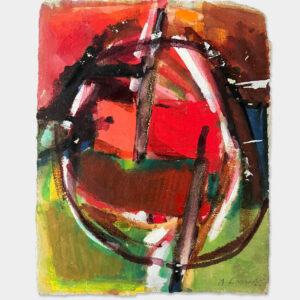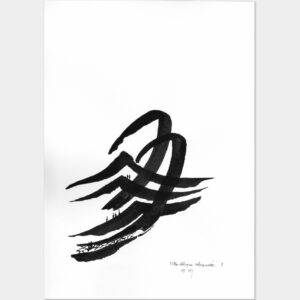Description
Pierre Alechinsky – Bouches et Grilles, 1986, Galerie Maeght Lelong
This book is the catalog of the exhibition of the same name that took place at the Galerie Maeght Lelong. It presents the artistic work French painter Pierre Alechinsky did with manhole covers from France and other countries. Taking their prints, he was then enriching them so the prints became part of a larger art piece in which the circles became iconic analogies of other objects (wheel, ring, bread, cosmic object, grinding stone, sun, etc.) The final art pieces, resembling medieval illustrations or strange mandalas, sometimes landscapes, are always fascinating.
Published in April 1986 by the Galerie Maeght Lelong (collection Repères, cahier d’art no 29).
The book, written in French, has an introduction by renowned art critic and collector Pierre Descargues.
His works are held in the collections of the Royal Museums of Fine Arts of Belgium, the Tate, Museum Ludwig in Cologne, the New York Museum of Modern Art, the Walker Art Center in Minneapolis, the Art Museum of Southeast Texas in Beaumont, Texas, the Museum of Art Fort Lauderdale, Nova Southeastern University in Fort Lauderdale, Florida. The main-belt asteroid 14832 Alechinsky was named in his honor in October 2000.
Pierre Alechinsky – Bouches et Grilles,
Published by Galerie Maeght Lelong
Collection: Repères – cahiers d’art contemporain
1986
32 pages – with color and black & white illustrations
Text by Pierre Descargues
8 3/4″ x 12 1/4″ – 22cm x 31.5cm
Excellent condition, with slight age marks on the back cover, but the book is otherwise in great condition.
https://en.wikipedia.org/wiki/Pierre_Alechinsky
https://www.guggenheim.org/artwork/artist/pierre-alechinsky
“Pierre Alechinsky (born in October 1927) is a Belgian artist. He has lived and worked in France since 1951. His work is related to Tachisme, abstract expressionism and lyrical abstraction.” He was part of the Cobra art movement.
Born on October 19, 1927, in Brussels, Pierre Alechinsky grew up with varied artistic interests that included graphic techniques, folk art, and medieval book illustrations. From 1944 to 1948 he studied art at the École nationale supérieure d’architecture et des arts décoratifs (La cambre), Brussels. Alechinsky joined the group Jeune Peinture Belge (also known as Jonge Belgische Schilderkunst, young Belgian painters, 1945–48) and had his first solo exhibition in the Galerie Lou Cosyn, Brussels, in 1947. During a stay in Paris in 1948, he was deeply impressed by the work of Jean Dubuffet and Max Ernst, feeling particularly drawn to the former’s Art Brut. In March 1949, Alechinsky visited an exhibition featuring artists from the Cobra group (1948–51) at the Séminaire des arts, an experience that would have a lasting effect. Formed by painters from Copenhagen, Brussels, and Amsterdam, the movement distinguished itself through bold, expressive compositions inspired by folk and children’s art, as well as by the work of Paul Klee and Joan Miró.
From 1949 to 1951, Alechinsky devoted himself so intensely to Cobra—organizing exhibitions and running the group’s eponymous magazine (eight issues, 1949–51)—that he produced little work of his own. His distinctive use of script as a means of pictorial expression came out of his exposure to Cobra artists such as Karel Appel and Asger Jorn, and in 1951 he moved to Paris to study engraving. While there, he discovered an interest in Asian calligraphy. He traveled to Japan in 1955 and the following year made Calligraphie japonaise, a film about Japanese calligraphers. Fascinated by the way they placed paper on the floor and bent over, using their entire bodies to make their works, Alechinsky adopted the method.
Around 1958, his subject matter became more fantastic in nature, and he began using brightly colored acrylics to render comically deformed creatures that often communicate via speech bubbles. The creatures recall Hieronymus Bosch, Pieter Brueghel, and James Ensor—Flemish painters that Alechinsky admires and to whom he sometimes pays homage in his paintings. Since the mid-1960s, Alechinsky has worked primarily on paper. He has returned to his roots as a student in Brussels in his later work that refers to medieval pictorial illustration. From 1983 to 1987 he was a professor of painting at the École nationale supérieure des beaux-arts, Paris. His work has been included in group exhibitions at the Institute of Contemporary Arts, London (1958); Venice Biennale (1960, 1972); Pittsburgh International (now Carnegie International, 1961, 1977); São Paulo Biennial (1963, 1989); and Guggenheim Museum (2009), among other venues. He has received numerous international solo exhibitions at institutions as diverse as the Palais des beaux-arts, Brussels (1955, 1969); Stedelijk Museum, Amsterdam (1963); Museum of Fine Arts, Houston (1967); Musée national d’art moderne Centre Georges Pompidou, Paris (1975, 2004); Guggenheim Museum (1987); Taipei Fine Arts Museum (1992); and Jeu de Paume, Paris (1998, 2003). Musées royaux de beaux-arts de Belgique, Brussels, mounted a major retrospective in 2007. Alechinsky lives and works in Paris.






